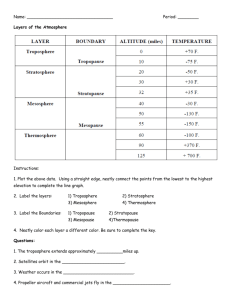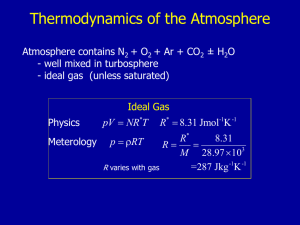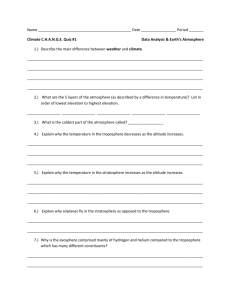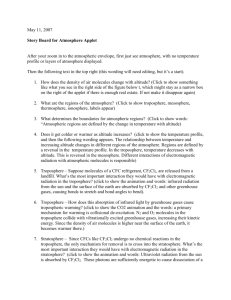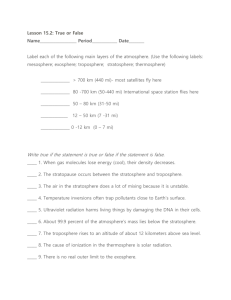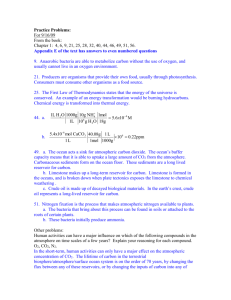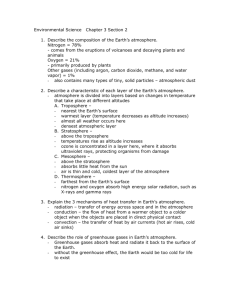Atmospheric Comp and..
advertisement
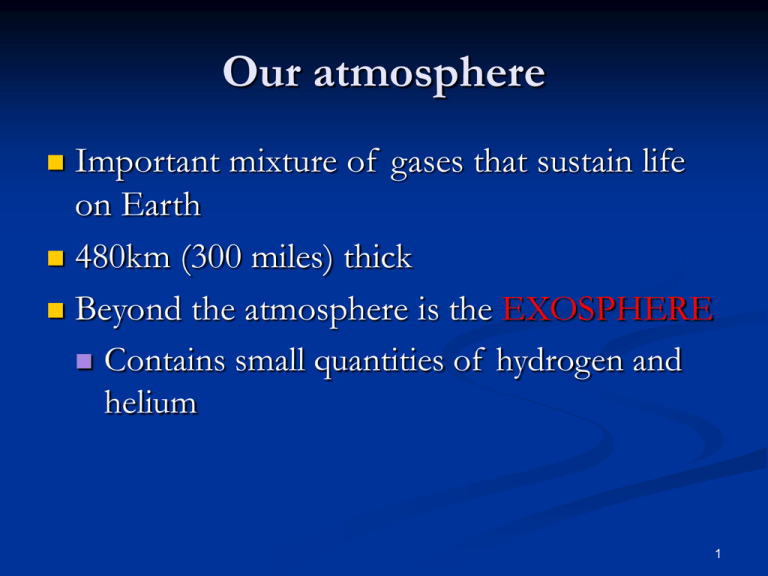
Our atmosphere Important mixture of gases that sustain life on Earth 480km (300 miles) thick Beyond the atmosphere is the EXOSPHERE Contains small quantities of hydrogen and helium 1 Major components of the troposphere 2 Major Atmospheric Components Nitrogen Originates mostly from volcanic sources Without nitrogen there would be no life Oxygen By-product of photosynthesis Concentration of oxygen varies with latitude 3 Argon Constitutes almost 1% of the atmosphere Not necessary for life but it used for some economic purposes Carbon dioxide By-product of life Important for keeping atmosphere warm increases in CO2 can cause an increase in atmospheric temperature Water vapor Variable from near 0 – 4 % 4 5 The Atmospheric Profile 6 The Atmosphere The thermosphere The mesophere The stratosphere The troposphere 7 The Troposphere (weathersphere) Water vapor, clouds, pollution, and life occur within the troposphere ~ 18km (11 miles) thick at equator; 12 km (8 miles) thick in the mid-latitudes; and 8km (5 miles) thick near the poles Top of troposphere known as the tropopause 8 Lapse Rates in the Troposphere As we go upwards in the troposphere, the temperature decreases 6.4°C/1km or 3.5°F/1000ft = AVERAGE This number is not that important Can vary considerably with varying weather conditions and locations 9 10 The stratosphere Temperatures increase from -57°C at the base of the stratosphere to O°C at the top (50km above Earth’s surface) Why? Top of the stratosphere is called the Stratopause 11 The mesophere 50 – 80 km above Earth’s surface Outer boundary known as the mesopause Temperature drops from O°C to - 90°C at the mesopause Occasional coalescence of cosmic and meteoric dust form clouds 12 The thermosphere Upper surface known as the thermopause Temperatures increase to ~1200°C at the thermopause 13 Atmospheric function Two main zones The ozonosphere The ionosphere 14 Functions of the atmosphere 15 Ozonosphere and Ionosphere OZONOSPHERE Contains a high level of ozone Efficiently absorbs UV wavelengths of energy Ozone is being depleted due to human activity IONOSPHERE Efficiently absorbs cosmic, gamma, x-rays, and UV wavelengths of energy Recent rebound 16 All the Earth’s energy ultimately comes from the sun Weather and climate are ultimately driven by The energy gain from the sun The Earth’s position relative to the sun Electromagnetic spectrum Mr. ROY G BIV 17 HOW TO REMEMBER THE ORDER OF VISIBLE LIGHT ROY G BIV RED ORANGE YELLOW GREEN BLUE INDIGO VIOLET 18 19 20 Solar radiation and Earth’s reradiation 21
